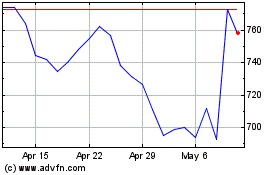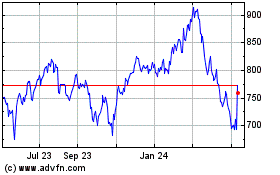UPDATE: Trading Community Operating As Normal After Quake
August 23 2011 - 3:55PM
Dow Jones News
Exchanges' trading operations and electronic market systems were
unaffected by the magnitude-6.0 earthquake that struck Virginia
early Tuesday afternoon, according to officials.
U.S. stocks came off their session highs following the quake but
the pullback was brief. The market has since resumed its rally and
is up about 305 points on the Dow Jones Industrial Average.
Gold, which had already settled for the day, took another leg
down in response to stocks rising. Recently, gold futures were 3%
lower in after-hours trading and recently hit an intraday low of
$1,830 an ounce. Oil and other industrial commodities dipped but
quickly recovered. Oil ended $1.02 higher at $85.44 a barrel.
Currencies showed little reaction to the earthquake. The dollar
slipped a few ticks against the yen in the seconds after the
earthquake, but within minutes regained those small losses. The
dollar was most recently trading at Y76.67, just above the Y76.65
level seen in the moments before the earthquake.
Treasurys initially got a boost from the quake but the bid has
faded as U.S. stocks rallied back again. The 10-year benchmark
Treasury note recently traded 14/32 lower to yield 2.139%. The
30-year bond was 1 10/32 lower to yield 3.47%.
Representatives for NYSE Euronext (NYX), Nasdaq OMX Group Inc.
(NDAQ) and BATS Global Markets said that dealing in securities and
stock options continued unabated following the earthquake.
The New York Stock Exchange's downtown New York trading floor
wasn't evacuated, nor was Nasdaq's Philadelphia options-trading
floor, though NYSE floor officials warned of potential
aftershocks.
"It felt like there was a subway train going underneath the
building," said Jonathan Corpina, senior managing partner of
Meridian Equity Partners, a broker on the NYSE floor.
He said everyone paused for about 20 seconds before it was
"business as usual" again.
Keith Bliss, senior vice president at Cuttone & Co., a
brokerage on the NYSE floor, said some traders on the floor felt
their monitors shake, but there was no damage. "We're trading away
now," he said.
Some traders departed the New York Mercantile Exchange floor,
but no official evacuation notice was given by the exchange and
trading continued as per normal, according to a spokesman for
parent CME Group Inc. (CME).
"Screens were shaking, booths were moving," said Peter Donovan,
vice president of Vantage Trading and a broker on the Nymex
floor.
The quake was a test for the high-tech infrastructure supporting
stock and derivatives markets that are now heavily electronic. New
York-area data centers run by NYSE Euronext and specialist firms
such as Equinix Inc. (EQIX) and Telx Group Inc. reported no issues
affecting the trades and messages among exchanges, brokers and
proprietary trading firms, according to spokespersons.
Spread Networks, which runs a high-speed corridor between the
New York and Chicago financial hubs, said its connections were
unaffected by the temblor.
Facilities housing exchanges' matching engines and the servers
used by traders to send orders into the market are built to
withstand catastrophes such as earthquakes, fires, floods and
lengthy power outages. NYSE Euronext over the past two years has
spent about $500 million constructing facilities in New Jersey and
the United Kingdom, with backup generators ensuring power continues
to flow in the event of a blackout.
Representatives for Citigroup Inc. (C) and J.P. Morgan Chase
& Co. (JPM) said their trading operations were operating as
normal and there were no major disruptions. J.P. Morgan said it
allowed employees to leave its New York buildings voluntarily, but
there were no forced evacuations and operations continued as
normal.
Tomasz Lesyk, a Citi employee in Stamford, Conn., said his
building on 750 Washington Blvd. was evacuated shortly after
employees felt vibrations. A few employees outside UBS AG's (UBS,
UBSN.VX) North American headquarters in Stamford said they weren't
evacuated, though some went outside on their own accord.
The quake's strength rating was upgraded from an initial 5.8 to
6.0 by the U.S. Geological Survey.
-By Jacob Bunge, Dow Jones Newswires; 312-750-4117;
jacob.bunge@dowjones.com
--Steve Russolillo, David Benoit and Daniel Strumpf contributed
to this article.
Equinix (NASDAQ:EQIX)
Historical Stock Chart
From Apr 2024 to May 2024

Equinix (NASDAQ:EQIX)
Historical Stock Chart
From May 2023 to May 2024
